 By Pepper Parr
By Pepper Parr
December 5, 2014
BURLINGTON, ON.
Shelley Raymond had a problem – both her parents were at that point in their lives when they needed a level of care she had not had to provide in the past.
Her Mother’s Alzheimer’s was advanced and her Father’s dementia while stable, made life demanding for her.
Where do they live when they can no longer care for themselves? There is nothing comfortable about the choices people like Shelley Raymond have to make.

Seniors will represent more than 25% of the population of Burlington in the not too distant future.
More than 14% of Canada’s population is over 65 and that number is going to grow – the Baby Boomers are moving into retirement.
Long term care is one option. According the Ms Raymond, a senior today has a 7% chance of getting a long term care bed,

Will Burlington be properly prepared for the growth in the seniors population?
Staying home, alone is the choice many make – but it doesn’t work. The isolation leads to depression; memory loss creates all kinds of problems – medication isn’t taken; repairs on the house just don’t get done; there are challenges with food preparation and falling down stairs or tripping over objects is very common.
Many, including Shelley Raymond believe the province faces a long term care crisis.
Seniors need some level of support for daily living activities – cooking, cleaning, shopping, transportation and medication reminders. Most seniors want to remain independent as long as possible; many try to remain independent and do themselves considerable harm both emotionally and financially.

A vital and pressing problem for a lot of families in Burlington.
Finding the level of care parents need is just one part of the problem – being able to pay for that care is the second part. The over-riding question is – how long will the money last?
What’s available in terms of care? Long term care facilities: $78 a day – $2400 a month for a private room; $56 a day for basic care – $1707 a month.

Depressing and scary – is this the best the province is going to be able to do?
Retirement homes come in at $3500 a month and can run up to $8000 a month with advanced services. These are now growth businesses. The Pearl at Pine is preparing to open seen, the six floor residence on Upper Middle Road next to the Tansley Woods community centre has been open for more than a year and Aldershot has a new retirement community.
The other options are staying in your home or moving in with family.
For those who choose to stay in their homes there is an additional issue and that is home care offered by the province’s Community Care Access Centre (CCAC). There are limits to the number of people they can handle – the number of senior’s that will need care is not as limited. There is a crunch coming.
There are literally tens of thousands of seniors facing this problem – and they are beginning to realize that the government is not going to solve their problem for them. People are coming up with good ideas – that’s what Shelly Raymond had to do when her parents needed care.
Remember that television program The Golden Girls – they are on the way back. Sharing accommodation was an entertaining idea – Shelley Raymond took it a couple of steps further and developed the idea of what she calls “co-housing”.
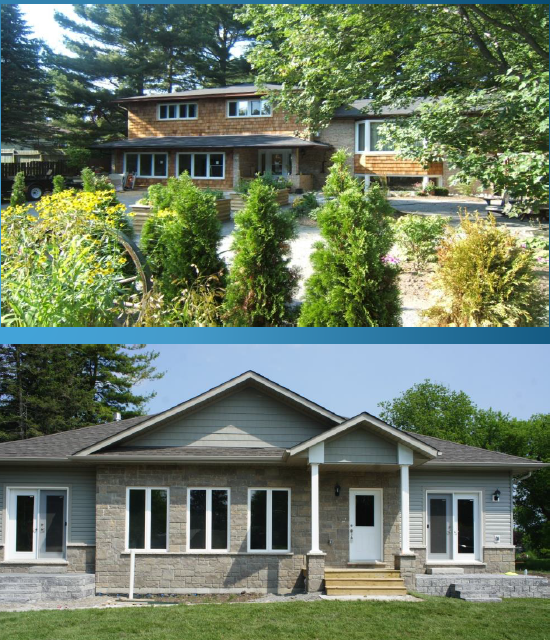
Top house was renovated to become a cohouse. Bottom was purpose built to be a cohouse.
She created an organization called Solterra that works with people who want to be part of a co-housing property. She looks for properties that can be used, works with architects to build the homes, markets them and then works with owners to get them set up with the services they want and need. Much more information on their web site. Tell Shelly you read about her in the Burlington Gazette.
People share the ownership of a building. Each resident has their own private space and share common space – kitchens, living room and perhaps gardens.
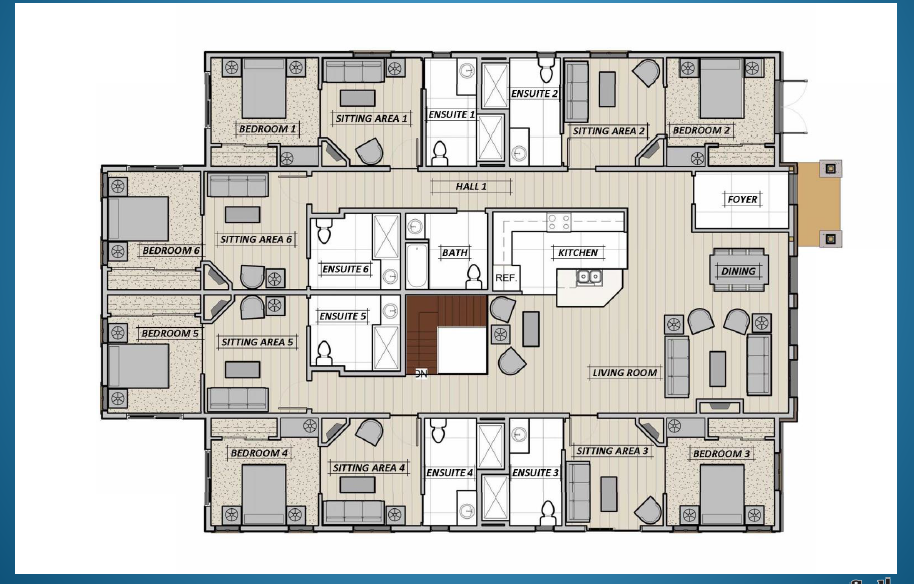
Floor plan for a six unit cohouse.
Typical “co-houses” have four to six owners. Each owner has title to their portion of the house which can be sold on the open market. They share the taxes, the heating and electricity, maintenance.
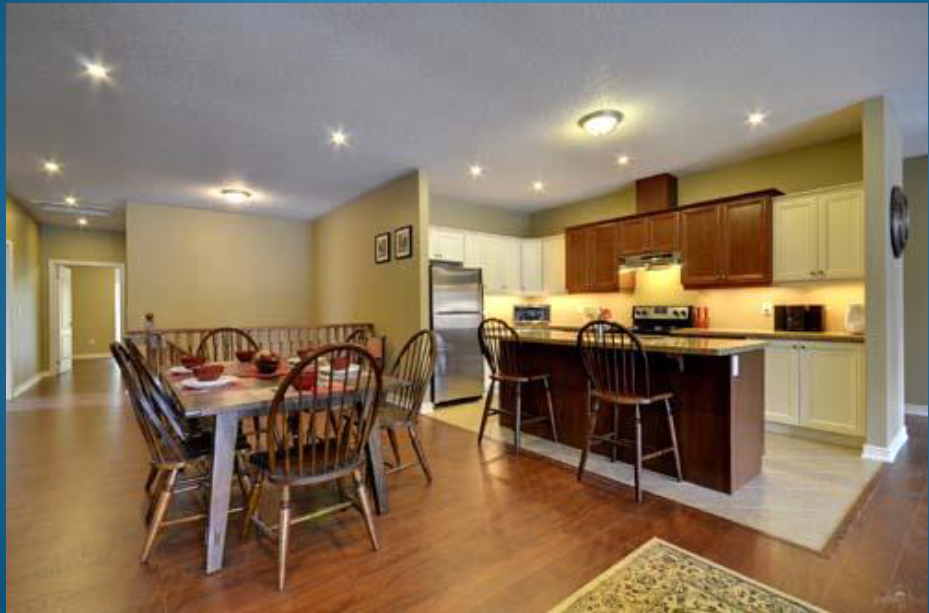
The kitchen area of a cohouse in Brechin Ontario
There is also the potential to share household services as well – which many of the cohousing operations do. Someone comes in and does the cleaning; some have a person who comes in and does the cooking and meal preparation. There are various levels of service that are possible. The owners decide what they want and can afford.
Most of the units have small walk outs to a private yard in some cases or a common area in others. Parking, transportation – and what about pets.
The basic rule is usually no pets but the owners of the units are the “board of directors” and they can make any decision they like. “One cohousing operation voted to try a pet for a short period of time” explained Raymond. Sally, the dog is now the star of that house and has put in twenty pounds.
The biggest part of co-housing is the “co” part – decisions are made in common and people fashion the kind of community they want.
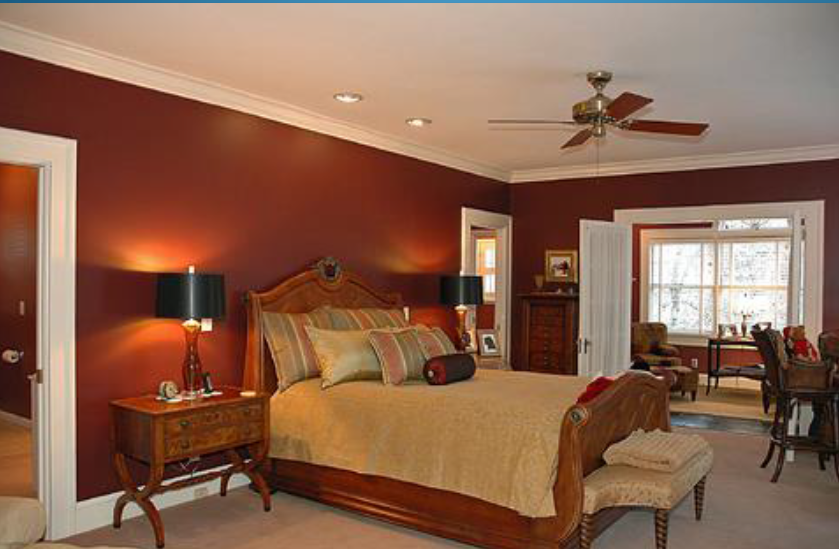
Owners bring their own furniture and set up their home the way they want.
How does one know that cohousing will work for them? Most of the cohousing organizations have a three month trial period. You move in – you pay “rent” and try it out. If you find that the people are your kind of people and the level of service is what you need – then you can buy your share of the house.
What are the advantages of cohousing? Financially they are incredible. Heating, electricity, taxes, maintenance are all shared by the people living in the home. And those people are not residents – they are the owners. The difference is that they share the ownership of the property. The house is not a nursing home – it belongs to the people who live in it.
They are purchasing a percentage interest in a home, freehold that is individually saleable on the open market, registered on title as Tenants in Common. It is a private residence in which you maintain your privacy and control
The Burlington Community Foundation recently published their third Vital Signs report in which they said “There will be greater emphasis on shifting care to the community and supporting aging in place. Home Care and Community Support Service agencies will support more elderly people with complex and often inter-related health and social care needs to remain in or return to their homes, especially after a hospitalization.
The report suggested Coordinated Care as an approach that will bring together patients, teams of health professionals including specialists, community partners, to ensure not only a positive health outcome but also a quality of life outcome for patients.
If current trends persist, there will continue to be a shortage of long-term care beds and this will result in more seniors staying in their homes out of necessity rather than personal choice and need. The hope is that substantially more spaces in long-term care homes will be created so that waiting lists and wait durations get smaller rather than larger.
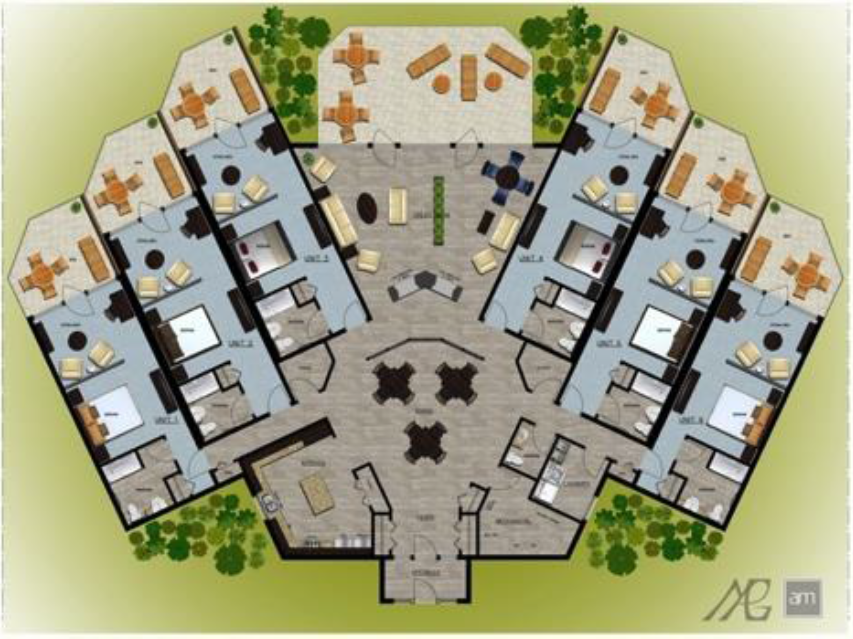
The layout, scope and size of a cohouse is limited only by the imagination of the developers ad the people who want to live in these homes.
Neighbourhood planning and building design will take into account the accessibility needs of seniors both in terms of mobility and to reduce the isolation of seniors. This will continue as part of the movement to develop age-friendly communities; something we have not heard very much from the Planning Department.

This is what cohousing is all about. It is one of the more imaginative and financially viable ideas to come along in some time.
And that is exactly where Shelly Raymond is going with her Solterra concept.
When she spoke recently in Burlington there were a number of women in the room who met with her after and asked – “How can we do this now?”
















Thank you for this very interesting article.
Great presentation Pepper! This concept is super for Halton Region. Burlington Age-Friendly Seniors Council has alternatives for Seniors in Housing. The Empowering Future Series of Events could present all the alternatives in one place in 2015. It is that ‘thinking outside of the box’ Shelley has that will help diminish isolation and depression in older adults. BAFSC Vision (since 2009): Burlington will be the best place to live work and play! With your Gazette it will truly help. Thank you so much! God Bless.
Great article Pepper. Thanks.
Most of us will need to plan for a future where we may not be able to live as independently as we do now. In order to secure a spot now, I wonder if rental of one’s unit is an option?
Absolutely, you own the interest in the shared home. You can rent your suite – having said that the decision to rent is subject to the co-ownership agreement and your housemates. You act as a group, a community and everyone agrees to the provisions of the co-ownership agreement and if the group decides one person can rent that all is good.
We rented in Bracebridge and it worked perfectly.
Great article – just to clarify – we focus on co-housing, not cohousing. There is a difference! For more information please visit our website at http://www.solterraco-housing.com
Please don’t hesitate to contact me about a project in your community.
705-645-0007, Toll Free: 877-833-0007